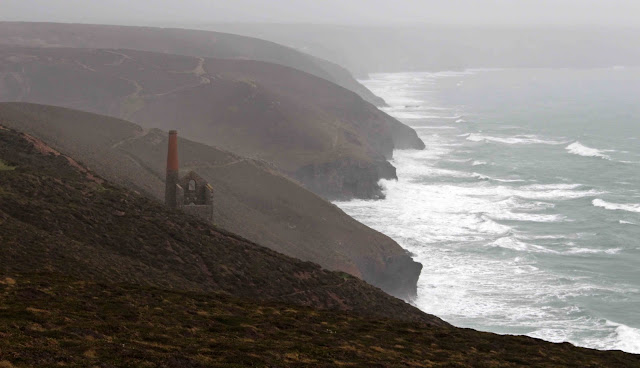It was Christmas Day, and most sensible
people were feasting on delectable festive morsels in their centrally heated dining
rooms or lounging about in their equally cosy living rooms, happily sheltering indoors
from the wild winds and squally rain being dealt out by Storm Barbara. Not us!
We were on holiday. We couldn’t waste daylight hours indoors. Instead, we
rugged up in winter woollies, scarves, hats, gloves and anoraks, and went
searching for Poldark!
Well, to be truthful, we went looking for
the wheel houses and other remains of tin mines we had noticed on our way home
the previous evening and then got a bit carried away in a more general search
for Cornwall’s mining heritage, following the seams of ore and old mining
tramways from one side of the Cornish peninsula to the other.
First up was a mine that must remain
nameless because, although I can find it on a map, I haven’t yet discovered its
name and therefore none of its history. This wheel house was part of a much
larger complex, the ruins of which could vaguely be discerned under a thick
covering of gorse and scrub.
We drove onwards, looking for mining
symbols on our map and, by chance rather than good navigation, we arrived at St
Agnes Head where we hit pay dirt. We parked near the National Coastwatch lookout station and walked to the cliff edge to scan the coastline for ruins,
and there, not too far south, through the mist / low cloud / drizzle / fog /
squally rain we could just make out a chimney.
 |
| - a protective cover over an old mine shaft and old dynamite blast holes |
Luckily, the gale-force winds were sweeping
in off the sea rather than blowing us towards the vertigo-inducing cliff edges,
so south we headed, staggering along trails that would originally have been
forged by miners trudging to and from work each day.
We had discovered Whealcoates, where
records of mining date from as far back as 1692, though archaeologists have
shown that men were digging for ore on the surface as early as the Middle Ages.
The most recent mine opened in 1802, closed in 1889, reopened in 1911, then
closed for good in 1913.
The ruins we saw that day include engine
houses dating from 1880 and 1910, the gas engine foundations dating from
1910-13, dressing floors from the 1870s, and, one of the most
photographed ruins in the whole of Cornwall, the dramatically sited Towanroath
Shaft engine house, perched further down the cliffs, nearest to the sea.
At its peak Whealcoates employed around 140
miners and its tin was transported along tramways to be shipped to national and
foreign shores from the ports of Portreath, Hayle, St Agnes and Truro
In spite of the weather – or, perhaps,
because of it, because it gave us more of an insight into the difficult
conditions faced by the miners on a daily basis – exploring the mining ruins at
Whealcoates that day was one of our best experiences in Cornwall. It was
certainly a Christmas Day to remember.









No comments:
Post a Comment